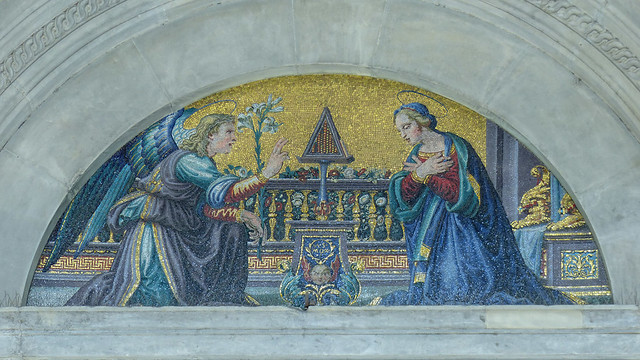Ornament to Humanism: The Annunciation in Fourteenth and Fifteenth Century Florence
The Annunciation: From Gothic Splendor to Renaissance Grace
The Annunciation, the moment in which the angel Gabriel greets the Virgin Mary with the message of the Incarnation, has long served as a touchstone for stylistic and theological change in Florentine art. Three examples spanning roughly a century, Pietro di Miniato’s late fourteenth-century fresco in Santa Maria Novella, Fra Angelico’s Annunciation at San Marco (c. 1438–1445), and Domenico Ghirlandaio’s mosaic Annunciation for the Basilica della Santissima Annunziata (c. 1489–1490), trace the evolution of the subject from the symbolic abstraction of the Gothic period to the luminous naturalism of the High Renaissance.

Pietro di Miniato’s version still belongs to the decorative world of the International Gothic style. The scene is contained within a rich architectural and ornamental framework that emphasizes surface beauty and theological symbolism. Figures are elongated, with graceful, stylized gestures and draperies that fold like patterned textiles. The shallow, compartmentalized space functions less as a real setting than as an ornamental stage for sacred narrative. Gold leaf and elaborate decoration dominate the composition, reinforcing the sense of divine transcendence. The emphasis is on the splendor of revelation rather than on the psychological encounter between the angel and the Virgin.

Fra Angelico’s Annunciation at San Marco, painted about half a century later, transforms the same subject into an image of quiet meditation and spatial harmony. Executed for the Dominican convent in Florence, the fresco reflects both the artist’s spiritual sensibility and the rational clarity of early Renaissance design. The setting, a serene loggia rendered in linear perspective, opens into a believable architectural space bathed in soft, natural light. Here the divine message is conveyed not through gold and ornament, but through the gentle interaction of two idealized yet human figures. Light defines volume, drapery follows the logic of the body, and color harmonies evoke contemplative calm. In Angelico’s work, divine revelation enters the human world without disturbing its quiet order. His Annunciation expresses the Dominican ideal of prayerful contemplation through the union of faith and visual reason, a distinctly Renaissance humanism in which grace is made visible through natural beauty.

Domenico Ghirlandaio’s Annunciation mosaic in the Basilica della Santissima Annunziata continues this trajectory toward naturalism and visual eloquence while also reflecting the grandeur and technical sophistication of late fifteenth-century Florence. The figures of Gabriel and Mary retain Fra Angelico’s composure and dignity, but they are rendered with greater physicality and tactile presence. Ghirlandaio’s attention to architectural detail, textiles, and the luminous interplay of gold tesserae demonstrates his mastery of both Renaissance perspective and decorative richness. The golden background, now reimagined as a radiant light rather than a symbolic plane, merges Gothic splendor with Renaissance clarity. The spatial coherence and material refinement reflect the Florentine ideal of decoro, beauty, order, and balance in the service of sacred narrative.
Together, these three works trace a remarkable transformation in the visual language of the Annunciation. In Pietro di Miniato, the scene remains a symbolic tableau, a vision of the transcendent communicated through ornament and abstraction. In Fra Angelico, it becomes a meditative encounter between the divine and the human, rendered through space, light, and quiet emotion. By the time of Ghirlandaio, the sacred event has become fully integrated into the natural, architecturally ordered world of the Renaissance, where divine radiance and human reason coexist in harmonious splendor.
The progression from Miniato to Angelico to Ghirlandaio mirrors the larger intellectual and spiritual shift of fifteenth-century Florence: from the otherworldly mysticism of the Gothic toward the human-centered theology and measured beauty of the Renaissance. In this evolution, the Annunciation ceases to be merely a revelation witnessed from afar and becomes instead a moment of inward grace, a dialogue between heaven and earth rendered in the luminous language of human art.
